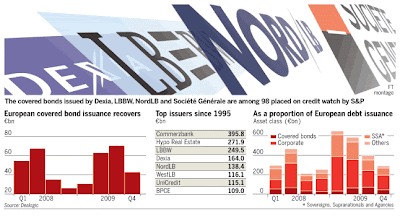By Anousha Sakoui
Published: December 17 2009 19:32
Covered bonds have been one of the more resilient parts of the structured credit market this year. But this week the asset class was thrown into the spotlight when Standard & Poor’s threatened to downgrade the vast majority of the covered bond programmes it rates in Europe, US and Canada.
The move affected €1,460bn ($2,154bn) of debt linked to 98 (mainly European) programmes, and follows the rating agency’s decision in February to revise globally its methodology and assumptions in light of the financial crisis.
The move, which came on Wednesday, shocked and disappointed some in the market who felt it did not reflect the fundamentals of the asset class. Most covered bond programmes have retained their triple-A ratings throughout the crisis and some are now at risk of losing it.
Covered bonds are backed by pools of mortgages or public debt, but crucially, in the event of a default, investors also have recourse to the balance sheet of the bank that issued them. This year the market received a boost from the European Central Bank which said it would buy back €60bn of these securities, triggering an increase in demand from investors.
The new methodology set out by S&P will place greater emphasis on asset and liability mismatches in covered bonds when determining credit ratings and introducing a closer link to the rating of the bank issuers.

These categories will depend on the jurisdiction of the bond issuer, the ability to raise third party liquidity or sell the assets and the likelihood of government support.
Analysts at Barclays said they did not believe the move would have substantial immediate implications for spreads. But as the final downgrades come into effect over the next four months, covered bonds from lower rated institutions with liquidity profiles categorized as poor by S&P would suffer higher spread volatility.
“The sheer scale of the watch action has come as a shock to the market,” said Michael Cox, analyst at Chalkhill Partners, a boutique investment bank. He said investors were still trying to work out the implications of the downgrades for the covered bond market as a source of funding going forward. “If banks have to add more collateral that will make the programmes less efficient,” he said. “The move by S&P is very disappointing,” said Tim Skeet, head of covered bonds for Bank of America Merrill Lynch. “What (S&P) has done is mildly improved from what they initially proposed but still means a great swathe of issuers are going to be clobbered by this. Is this really the right way to treat this asset class given how resilient it has been in the face of the crisis?”
Mr Cox believes the downgrades could have a negative impact on other markets: “While many issuers could take action to boost the collateral in the pools to avoid downgrades (with a knock-on impact on unsecured bank creditors), there remains the potential for meaningful downgrades to a significant chunk of the covered bond market,” he said. “This will undoubtedly cause disruption to a market that has been one of the principal sources of finance for mortgages this year, and it therefore has the potential to have a negative knock-on impact on the availability of finance in the residential and commercial property markets.”
Other bankers believe it will do little to shake investor confidence.
“This won’t halt issuance but it will create more of a tiering of spreads between different issuers, which will likely be welcomed by investors looking for yield.” said Ted Lord, Head of European Covered Bonds at Barclays Capital. “As governments look to exit support packages, central banks have been encouraging financial institutions to stop funding through the central banks and turn instead to the markets and the first place they will do that will be in the covered bond market. ”
Copyright The Financial Times Limited 2009
0 comments:
Publicar un comentario